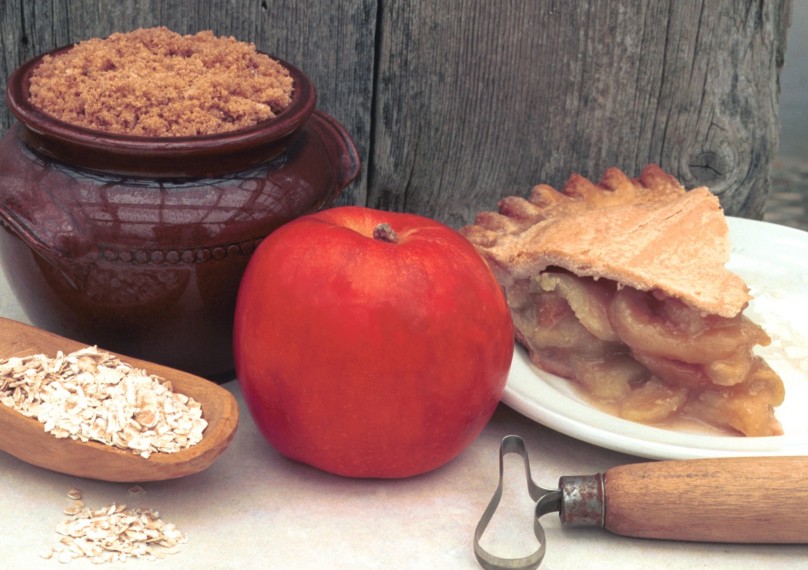
Gravenstein apples were likely brought to Nova Scotia by Charles Prescott around 1800. At his estate, Acacia Grove, he developed extensive gardens and took a keen interest in horticulture. He brought in many fruit trees or scions from other countries to see if they would grow well in the Nova Scotian climate and the Gravenstein thrived. It is said that by the time Prescott died in 1859, every Nova Scotia farm had at least one Gravenstein tree. The Nova Scotia Gravenstein is an early season favorite of just about everyone who tastes it. The Nova Scotia Gravenstein is the quintessential multi-purpose apple. It has a delightful flavor and is very juicy when eaten fresh; it is a wonderful cooking apple and also good for making cider. Gravenstein apples also store successfully for several months in cold storage. Gravensteins do not ripen all at the same time, which may be another reason for their popularity on small mixed farms of the past.
Most Gravensteins, like the ones Charles Prescott popularized, have a delicate, waxy yellow-green skin with crimson spots and reddish lines. However, they can also be found with red skins. The oldest red Nova Scotia Gravenstein strains date to 1876, when a Gravenstein tree was found on the farm of Stanley Banks in Waterville, Kings Co. that bore fruit with red streaks. This was named ‘Banks Gravenstein.’ It grew in popularity with growers and consumers on account of its color. It has sometimes been referred to locally as the ‘Banks apple.’ In 1912 another red Gravenstein was found and named ‘Crimson Gravenstein.’ In Nova Scotia the green/yellow Gravensteins, which have been grown for nearly two centuries, are called Old-Fashioned Gravensteins to differentiate them from the two ‘newer’ red strains, the youngest of which is nearing the century mark.
While Gravensteins used to be grown in most major apple growing regions of the world, they fell out of favour with the increase in global agriculture and now are severely threatened. In fact, during the first half of the 20th century, Gravensteins were the major variety of apples grown in northern California and were the source for apple sauce and dried apples for US soldiers in World War II. Today the majority of those commercial orchards, like those in Canada, have disappeared due to suburban development, wine production, and changes to the global apple industry.
Where to source:
Nova Scotia
Suprima Farms
902 582 3044
1388 Middle Dyke Rd
CANNING, Nova Scotia
Other vending sites include:
Wolfville Farmers Market
902 697 3344
24 Elm Ave
Wolfville NS
Halifax Farmers Market
902 429 6256
1209 Marginal Rd
Halifax, NS
Cape Breton Farmers Market
902 371 1481
340 Keltic Drive
Cape Breton, NS
Wright Farms
373 Hubbard Mtn Rd
Pereaux, Nova Scotia
Apple Lane Farm Inc. (pick your own)
902 538 7376
54 Prospect Rd
Morristown, Nova Scotia
Sterling Fruit Farms
Vending sites include:
Farmers Markets:
Bible Hill, Nova Scotia
902 895 4956
325 Main St.
Blue Acres, Nova Scotia
902 755 2458
339 Bridge Ave.
Wolfville, Nova Scotia
902 542 2789
10317 Highway 1
Saint John, New Brunswick
506 652 3105
666 Rothesay Avenue
Moncton, New Brunswick
506 856 8281
840 Shediac Road
Daniel’s U-Pick
902 798 5432
4499 Route #14 (Chester Rd.)
Windsor Forks, NS
Boates Orchard (pick your own)
902 678 7671
432 Bligh Road
Woodville, NS
Willow U-Pick Farm & Market
902 542 9153
110 Starr’s Point Loop
Port Williams, NS
Photo credits: Nova Scotia Fruit Growers Association
I live in Toronto, Ontario. Is it possible to purchase these apples and have them sent here? Thank you.